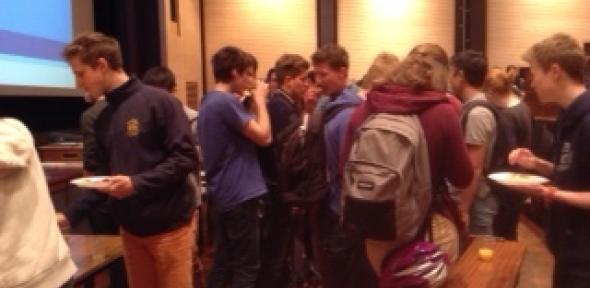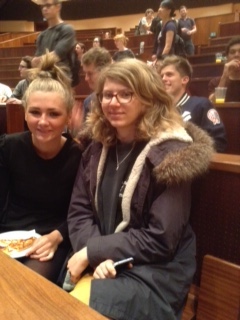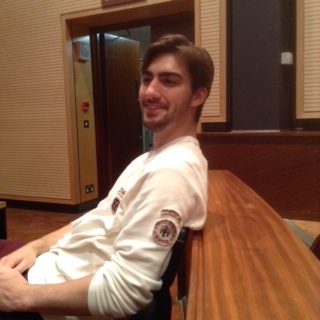
Enjoying a pizza lunch before the talk on chemistry courses
Over 160 undergrads turned out for a pizza lunch followed by an informative talk on “Chemistry beyond the first year,” on the 14th and 19th of May.
After avidly demolishing the vast amounts of pizza on offer, the students settled down in the BMS lecture theatre to find out more about the possible routes into Chemistry after the first year of the Natural Sciences tripos.
Director of Teaching James Keeler started with a very clear presentation on the years following Part 1A, followed by several students at various stages of the tripos, who gave their perspectives on the pros and cons of different course combinations.
Second year (part 1B)
James explained that in the second year, known as Part IB, students are encouraged to take both Chemistry A and Chemistry B if they want to proceed to Chemistry in their third year (known as Part II). Students can go on to Part II having taken only Chem A or Chem B, although this limits some of the options available.
James explained that Chemistry A is broadly physical and theoretical while Chemistry B focuses more on organic, inorganic and biological topics. The student speakers gave examples of other courses they took with Chem A and Chem B, as well as their advantages and disadvantages; one student who had taken only Chem B before going on to Part II, said it had worked for him, although missing the maths elements meant having to do some catch-up work.
Third year (part II)
Students who go on to Part II (third year Chemistry) have an opportunity to start specialising in particular topics from the wide range on offer, along with taking required core courses. Courses generally consist of 12 lectures, with three to four supervisions that are taught in the department rather than in college.
A popular component of Part II is the language option, in which students can learn a foreign language in a two-term course at the Engineering Department language unit. French, German, Spanish, Japanese and Chinese are offered.
Fourth year (part III)
Finally in the fourth year (Part III), students choose a research project, which is 25 percent of their grade. Several students spoke about how exciting it was to meet the research groups and to get involved in real, front line research.
The other exciting aspect of Part III is the wide range of courses on offer, which reflect the research interests in the Department, with no compulsory modules. Recent courses have included protein folding, misfolding and disease; advanced diffraction methods; stereo-controlled organic synthesis; computer simulation methods in chemistry and physics; atmospheric chemistry and global change; materials, electronics and renewable energy; supramolecular chemistry and self-organisation; and nano science and colloid science (chemistry at small length scales) amongst many others.
Supervisions continue for many of the courses, allowing for close monitoring and teaching, while the emphasis is always on learning concepts.
After the presentation, there was a chance to ask lots of questions of both the students and James Keeler, as well as to retrieve any remaining pizza.

Students who helped in the presentation included Andrea Chlebikova, Christina Gladkova, Joe Hooton, Ben Lewis, Henry Male, Aurimas Narkevicius, Maya Petek, Tom Sayer, James Thompson, Gerry Vistal and Cameron Wallace. Thanks are due to James Keeler, Bethan Lewis, and the students for organising and participating in the talks.
Tom Sayer, who spoke about his experience as an undergraduate.
